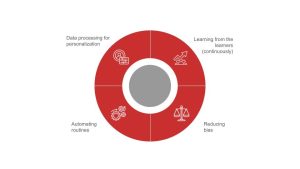The fact that the terms “Machine Learning” and “eLearning” are etymologically related is not just a coincidence. Just as the machines started learning from humans, one of the most obvious applications of ML (and, conversely, AI in general) has been making the machines teach humans in turn. Machine learning in education is now being fleshed out as a working model for countless startups, established companies, and formal institutions, colleges being one of the latter.
Role of ML in education
As of 2021, the global machine learning for education market was valued at USD 1.82 billion with a CAGR of 36.0% from 2022 to 2030. An additional factor in the propagation of ML for EdTech is that education itself is getting digitized through smartphone-driven consumerist philosophies, what with about 85% of today’s students (high school and college alike) using mobile tech for educational purposes on a daily basis.
So what’s the picture of ML in education so far? Let’s look at some defining factors and how these cards are being played across the EdTech landscape.
How ready is the world for ML in education?
Granted, those of us who grew up still being taught cursive at school will view the ML advent with at least some healthy pinch of suspicion. After all, it was only in 2015 that we were repeatedly told that by 2020, classrooms will be packed with VR and AR tech, but in most places that don’t look like they’re training surgeons or pilots, this wasn’t the case, not even during the quarantine lockdowns.
However, ML is much more likely to actually revolutionize everything, simply because the average user doesn’t really have to pay for gear to use it. In many cases, we don’t even realize we’re interacting with ML in this way or another; all that suffices is our trusty phone or PC. Meanwhile, the need to embrace ML is driven by growing investments, and the pressing need for personalized learning solutions.
Of course, this readiness will vary depending on your target region and demographics. There are several factors along which you could measure it:
Hardware and infrastructure
A robust technological infrastructure is a foundational requirement for the effective implementation of ML in education. According to the International Telecommunication Union (ITU), as of 2022, approximately 66% of the global population had access to the internet. This widespread connectivity is essential for leveraging ML-based educational tools and platforms. For instance, countries like South Korea and Finland, known for their advanced technological infrastructure, have successfully integrated ML into their education systems. South Korea’s Smart Education initiative utilizes ML to offer personalized learning experiences, significantly improving student outcomes.
In contrast, developing countries face challenges related to infrastructure and access. However, initiatives like the African Union’s Continental Education Strategy for Africa (CESA) 2016-2025 aim to bridge this gap by promoting digital literacy and investing in educational technology. As a result, there is a growing readiness in these regions, albeit at a varying pace.
Government Policies and Funding
Government policies and funding play a crucial role in the adoption of ML in education. In 2021, the U.S. Department of Education announced a $54.3 billion investment through the Elementary and Secondary School Emergency Relief Fund (ESSER) to support educational technology, including ML tools. Similarly, the European Union’s Digital Education Action Plan 2021-2027 outlines a comprehensive strategy to enhance digital education and promote the use of ML in schools and universities.
China,with its devotion to AI and ML research, has made significant strides in incorporating ML into its education system. The Chinese government’s New Generation Artificial Intelligence Development Plan aims to integrate AI and ML technologies across all educational levels, with substantial investments in research and development. These policies and funding initiatives indicate a strong commitment to preparing educational systems for ML integration.
Institutions
Educational institutions are at varying stages of readiness for ML adoption. A survey by EdTech Magazine found that 45% of K-12 schools in the United States have already implemented some form of AI or ML in their classrooms. For example, the New York City Department of Education has partnered with IBM to introduce Watson Classroom, an ML-based tool that provides personalized learning experiences and supports teachers in identifying students’ needs.
Higher education institutions are also embracing ML. Stanford University, for instance, uses ML to analyze student data and predict academic performance, helping advisors provide targeted support. Similarly, the Open University in the UK employs ML to personalize learning pathways and enhance student engagement. These examples highlight the growing readiness of institutions to integrate ML into their educational practices.
The readiness of educators and students to adopt ML tools is a critical factor in the successful implementation of these technologies. According to a report by Gallup, 65% of teachers in the United States believe that AI and ML can improve educational outcomes. However, only 15% feel confident in using these technologies effectively, indicating a need for professional development and training.
Students, on the other hand, are more receptive to digital learning tools. A survey by McKinsey & Company revealed that 60% of students worldwide have expressed a preference for personalized learning experiences enabled by ML.
Key benefits of machine learning in education
What is there that ML can actually do better than humans when it comes to the learning process? Machine Learning can draw on huge amounts of data, “juggle” multiple variables in decision making, and is impartial (insofar as it is properly trained on selected datasets). As of now, there are at least four areas where ML can leverage these traits to supplement eLearning:
- Personalization
Any tutor will admit personalized tactics work best; in fact, many of them subconsciously modify their teaching styles to fit the learner’s personality, even when they’re expected to follow a universal approach. The only reason the adequate level of personalization hasn’t become the norm is anxiety from the fact that humans will invariably base their teaching methods on their own experiences and previous interactions. However, now ML algorithms can analyze individual student’s learning patterns, strengths, and weaknesses, allowing less bias to sneak in and drawing on the insights from hundreds of tutors’ lifetimes at once. This sort of personalization ensures that each student receives content and assignments tailored to their specific needs, thereby enhancing their overall learning experience. - Improving Course Materials
This one is closely related to ML’s ability to analyze vast amounts of data. In this way, algorithms can identify gaps and redundancies in the curriculum. Moreover, ML can provide insights into which teaching methods are most effective, enabling continuous improvement in educational content delivery. In other words, it’s Wiki on steroids but with better balance, without a “war of edits” within. - Automating Administrative Tasks
Educator burnout is not a secret, and administrative tasks, such as grading assignments, managing enrollments, and scheduling classes, is a common culprit (some of us here in the team actually quit jobs in education because of that). ML can automate these routine tasks, freeing up time to focus on more critical aspects: and no, it’s not just lesson planning, it’s (crucially) interaction and trying to find the right approach to each student. - Reduced Bias
Bias in education can arise from various sources, including subjective grading and unequal access to resources. ML algorithms, when properly designed and implemented, can help reduce these biases. For instance, automated grading systems can ensure consistent and impartial evaluation of student work. Additionally, ML can identify and address disparities in educational content and resource distribution, promoting a more equitable learning environment.

Use cases
Adaptive Learning
Adaptive learning is essentially what good tutors have done for centuries when given such an opportunity: looking at each student’s performance at each given moment from several angles (overall motivation, prevalent memory type, preferred cognition patterns, etc.) to adjust things like task difficulty, format, and feedback in real-time, sometimes in a matter of minutes. This was somewhat lost during the industrial era, and especially at the early stages of digitalization, but adaptive learning platforms are now a category of eLearning that’s meant to set this straight.
Companies like DreamBox and Knewton are good examples of utilizing machine learning to tailor educational content to individual student needs. According to a study by McGraw-Hill Education, 82% of students who used adaptive learning tools reported an improvement in their grades. This personalized approach ensures that students are consistently challenged at an appropriate level, fostering more effective learning experiences.
Personalized Learning Pathways
Sometimes you just have to restructure the entire curriculum for a certain learning block to get the results you want as a tutor. The difficulty here is that, well, for every individual human to be taught, the learning pathway will be somewhat different, and if you’re tasked with teaching multiple people, you need to go by the principle “democracy isn’t always perfect, but it’s the best option out there” – meaning you take the approach that’s likely to work at least to some extent for everyone.
But ML can be taught to actually process individual insights to create personalized curricula. Platforms like Smart Sparrow use machine learning algorithms to create customized learning journeys based on each student’s progress and performance. There is also great demand for that. For instance, a study conducted by the Bill & Melinda Gates Foundation found that students using personalized learning tools were 30% more likely to advance in their learning compared to those using traditional methods.
AI Chatbots and Robotic Tutors
For a long time, the major disadvantage of eLearning was the lack of that special someone you can ask questions at any time. As of now, though, IBM’s Watson Tutor and the chatbot platform SnatchBot can provide instant assistance, answering students’ questions and offering explanations around the clock. According to a survey by the University of Granada, 75% of students who used AI chatbots for academic support reported increased satisfaction and engagement with their coursework. These tools ensure that help is always available, promoting continuous learning and reducing the strain on human educators.
Routine Automation
Routine automation is streamlining administrative tasks in educational institutions. Tools like Teacherbot and GradeScope leverage ML to automate tasks such as attendance tracking, grading assignments, and sending reminders. A report by EdTech Magazine highlighted that automation tools can save educators up to 13 hours per week, allowing them to focus more on teaching and student interaction. This efficiency not only reduces the administrative burden but also enhances the overall educational experience.
Inclusive Education
Machine learning is playing a crucial role in making education more inclusive. For example, Microsoft’s Seeing AI app uses ML to help visually impaired students by describing their surroundings and reading text aloud. Similarly, apps like Otter.ai provide real-time transcription services for students with hearing impairments. According to the National Center for Learning Disabilities, ML-driven tools have improved access to education for over 7 million students with disabilities in the United States alone, ensuring that all students have equal opportunities to succeed.
ML-Corrected Teaching Methodology
ML algorithms are helping educators refine their teaching methodologies by analyzing the effectiveness of various teaching strategies. Platforms like Coursera and Udacity use data analytics to continuously improve their courses based on student performance and feedback. A study by MIT found that courses utilizing ML-corrected methodologies saw a 20% increase in student completion rates. This data-driven approach ensures that teaching methods are constantly evolving to meet the needs of learners.
Fraud Detection
With the rise of online education, academic fraud has become a growing concern. Machine learning algorithms are being employed to detect and prevent fraud by analyzing patterns and anomalies in student behavior and submissions. Companies like Turnitin and ExamSoft use ML to identify potential instances of plagiarism and cheating. According to a report by the International Center for Academic Integrity, schools using ML-based fraud detection tools have seen a 50% reduction in academic dishonesty cases, maintaining the integrity of the learning process.
Challenges
While the benefits of ML in education are fun to talk about, there are still some challenges to address. Data privacy and security are paramount concerns, as educational institutions handle sensitive information. Ensuring the ethical use of ML algorithms and preventing biases in data and algorithms are also critical challenges. Moreover, significant investment in infrastructure and training for educators is required to effectively leverage ML technologies. According to a report by the World Economic Forum, 60% of educational institutions cite cost and lack of technical expertise as major barriers to ML adoption.
Despite these challenges, the integration of machine learning in education holds immense potential to transform the learning landscape, making it more personalized, efficient, and inclusive. As technology continues to evolve, addressing these challenges will be crucial to fully harness the benefits of ML in education.
Conclusions
So by leveraging ML’s capabilities, educational institutions can offer tailored learning pathways, improve course materials, automate administrative tasks, and reduce biases. The potential of ML to transform education is immense, but it also comes with challenges such as data privacy, ethical considerations, and the need for significant investment in infrastructure and training.
As the educational landscape continues to evolve, staying ahead of these changes is crucial. If you’re an educator, administrator, or technology enthusiast looking to explore how machine learning can benefit your educational practices, now is the time to act. Embrace the future of education by integrating ML into your systems and methodologies. We at Lionwood can offer our own experience in both EdTech and ML projects to help use the latest developments for a better learning experience.














